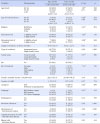Abstract
Purpose
This study was conducted to examine the impact of infection prevention program on the knowledge and performance among married Vietnamese immigrant women an infant or child.
Methods
A non-equivalent control group pretest-posttest design was used. Participants were 53 Vietnamese women with an infant or a child in G city. The treatment (n=25) received an infection prevention program series that included eight sessions over a four week period with four time through telephone interviews a weekly intervals. Data were collected between October 26 and December 14, 2012, and were analyzed Chi-square, t-test, and repeated measure analysis of variance with SPSS/WIN 18.0.
Figures and Tables
References
1. American Academy of Pediatric & American Public Health Association. Caring for our children, national health and safety performances standard. Washington, DC: Author;2002. DOI: 10.1249/mss.0b013e3180616b27.
2. Bae KE, Lee KH, Kim YH, Kim S, Kim HK, Kim JH. Child-rearing practices and parenting efficacy of marriage-immigrant women. J Korean Acad Child Health Nurs. 2010; 16:175–183. DOI: 10.4094/jkachn.2010.16.3.175.

3. California Child Care Health Program. Module I Prevention of Infectious Disease. 2004. Retrieved November 19, 2012. from http://www.ucsfchildcarehealth.org./pdfs/Curricula/idc2book.pdf.
4. Choi EJ, Hwang SY. Effects of case-based small group learning about care of infected children for daycare center teachers. J Korean Acad Nurs. 2012; 42:771–782. DOI: 10.4040/jkan.2012.42.6.771.

5. Foster JA, Chen JS. General principles of disease transmission. Pediatr Ann. 2002; 31(5):293–298. DOI: 10.1111/j.

6. Gibson N, Cave A, Doering D, Ortiz L, Harms P. Socio-cultural factors influencing prevention and treatment of tuberculosis in immigrant and Aboriginal communities in Canada. Soc Sci Med. 2005; 61(5):931–942. DOI: 10.1016/j.

7. Giger J, Davidhizar R. Transcultural nursing: Assessment & Intervention. 5th ed.London: Mosby Elsevier;2008.
8. Jeon MS, Kang KJ, Park SH. A study on pregnancy, delivery, and infant rearing knowledge and educational need of marriage immigrant women. J Agric Med Community Health. 2011; 36(3):179–190. DOI: 10.5393/JAMCH.2011.36.3.179.

9. Jeong GH, Koh HJ, Kim KS, Kim SH, Kim JH, Park HS, et al. A study on health management of during pregnancy, childbirth, and the postpartum of immigrant women on a multi-cultural family. J Korean Acad Womens Health Nurs. 2009; 15(4):261–269. DOI: 10.4069/kjwhn.2009.15.4.261.
10. Jintrawet U, Harrigan RC. Beliefs of mothers in Asian countries and among Hmong in the United States about the causes, treatments, and outcomes of acute illnesses: An integrated review of the literature. Issues Compr Pediatr Nurs. 2003; 26(2):77–88. DOI: 10.1080/01460860390197844.

11. Joseph NP, Clark JA, Bauchner H, Walsh JP, Mercilus G, Figaro J, et al. Knowledge, attitudes, and beliefs regarding HPV vaccination: Ethnic and cultural differences between African-American and Haitian immigrant women. Women Health Issues. 2012; 22(6):571–579. DOI: 10.1016/j.whi.2012.09.003.

12. Kim EH, Lee EJ, Kim MJ, Park DY, Lee SH. Effects of an educational program of pregnancy and delivery on pregnancy related knowledge, newborn care knowledge, and postpartum care self-efficacy of marriage immigrant women. J Korean Acad Nurs. 2010; 40(1):78–87. DOI: 10.4040/jkan.2010.40.1.78.

13. Kim HK, Jeong IS. Effects of a newborn care education program on newborn care confidence and behavioral accuracy of primiparas in a postpartum care center. J Korean Acad Nurs. 2007; 37(1):125–134.

14. Kim JH. The development of a child health education program for multi-cultural mothers. Seoul: Ewha Womans University;2009. Unpublished doctoral dissertation.
15. Kim JS. The effect of an infection prevention program in child day-care centers. Seoul: Seoul National University;2007. Unpublished doctoral dissertation.
16. Kim SK, Kim YK, Cho HR, Lee HK, Sul DH, Jeong GS, et al. A national survey on multicultural families. Seoul: Korea Institute for Health and Social Affairs;2009.
17. Korea Centers for Disease Control and Prevention. National Notifiable Infectious Diseases in Korea, 2007. 2010. Retrieved October 1, 2012. from http://cdc.go.kr/CDC/ info/CdcKrInfo0301.jsp?menuIds=HOME001-MNU0004-MNU0036-MNU0037&fid=31&q_type=title&q_value=%EB%B2%95%EC%A0%95%EC%A0%84%EC%97%BC%EB%B3%91&cid=12153&pageNum=1.
18. Korea Ministry of Gender Equality and Family. Guidebook for the maternity protection of women immigrants (Issue Brief No. 11-060100-000021-01). Seoul: Author;2005.
19. Korea Ministry of Health and Welfare. Everyday Life Guidance for Married Immigrants(Issue Brief No. 11-1460000-002928-01). Seoul: Author;2007.
20. Korea National Health Insurance Service. Health Insurance Forum. Seoul: Author;2012.
21. Kotch JB, Isbell P, Weber DJ, Nguyen V, Savage E, Gunn E, et al. Hand-washing and diapering equipment reduces disease among children in out-of-house child care centers. Pediatrics. 2007; 120(1):e29–e36. DOI: 10.1542/peds.2005-0760.
22. Lee DW, Kwon IS. Knowledge and practice of infection prevention by mothers of young children. J Korean Acad Child Health Nurs. 2009; 15(3):306–313. DOI: 10.4094/jkachn.2009.15.3.306.

23. Nam IS, Ahn SH. Comparison of stress, social support, and marital satisfaction between married immigrant women in urban and ural areas. Korean J Women Health Nurs. 2011; 17:99–108. DOI: 10.4069/kjwhn.2011.17.2.99.
24. National Association for the Education of Young Children & Academy of Pediatrics. Model child care health policies. 4th ed. Washington D.C.: NAFYC;2002.
25. Oh KS, Sim MK, Choi EK. Knowledge, selfconfidence and practice of teachers concerning health and safety of children in child-daycare centers. J Korean Acad Child Health Nurs. 2008; 14(2):155–162.
26. Pender NJ, Murdaugh CL, Parsons MA. Health promotion in nursing practice. 6th ed. Upper Saddle River, NJ: Pearson Prentice-Hall.
27. Statistics Korea. The level of education of married immigrants. 2009. Retrieved October 11, 2012. from http://www.kosis.kr/gen_etl/start.jsp?orgld=154&tblld=DT_MOGE_1001300042&conn_path=12&path.
28. Statistics Korea. Movement of population of multi-cultural family. 2011. Retrieved October 11, 2012. from http://kostat.go.kr/portal/korea/kor_nw/2/1/index.board?bmode=read&aSeq=251920.
29. Statistics Korea. Cause of death statistics. 2012. Retrieved October 11, 2012. from http://kosis.kr/gen_etl/start.jsp?orgid=101&tblId=DT_1B34E01&conn_path=I2&path=NSI.
30. Woo HK, Juong HS, Choi NY, Yi SH, Lee GI. Mothers' Korean language ability and preschoolers' language development in multi-cultural families. Korean J Child Stud. 2009; 30(3):23–36.




 PDF
PDF ePub
ePub Citation
Citation Print
Print






 XML Download
XML Download